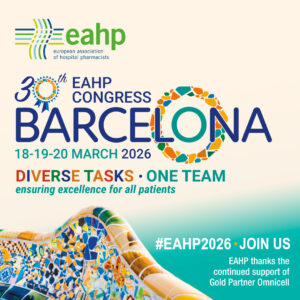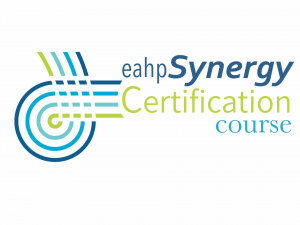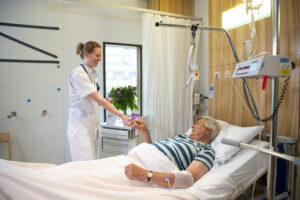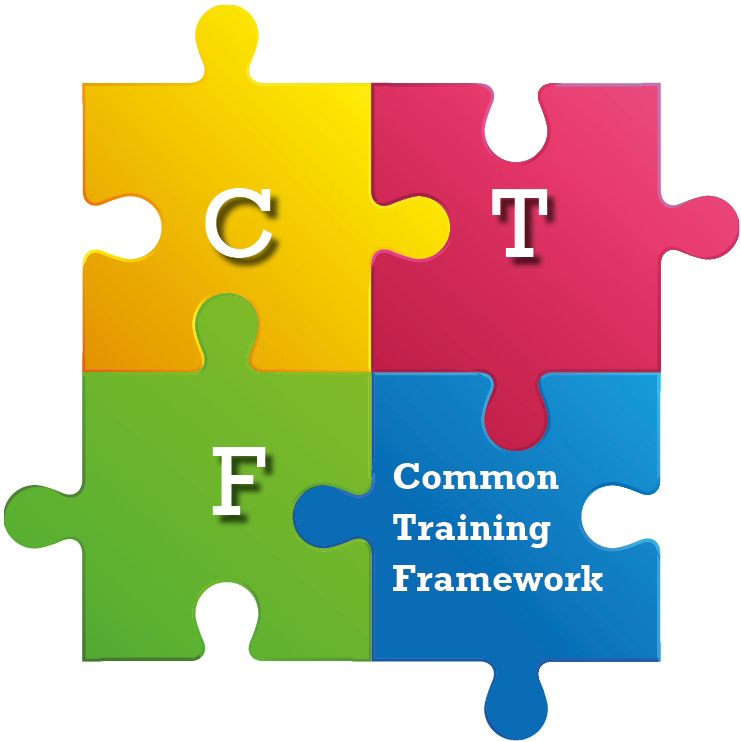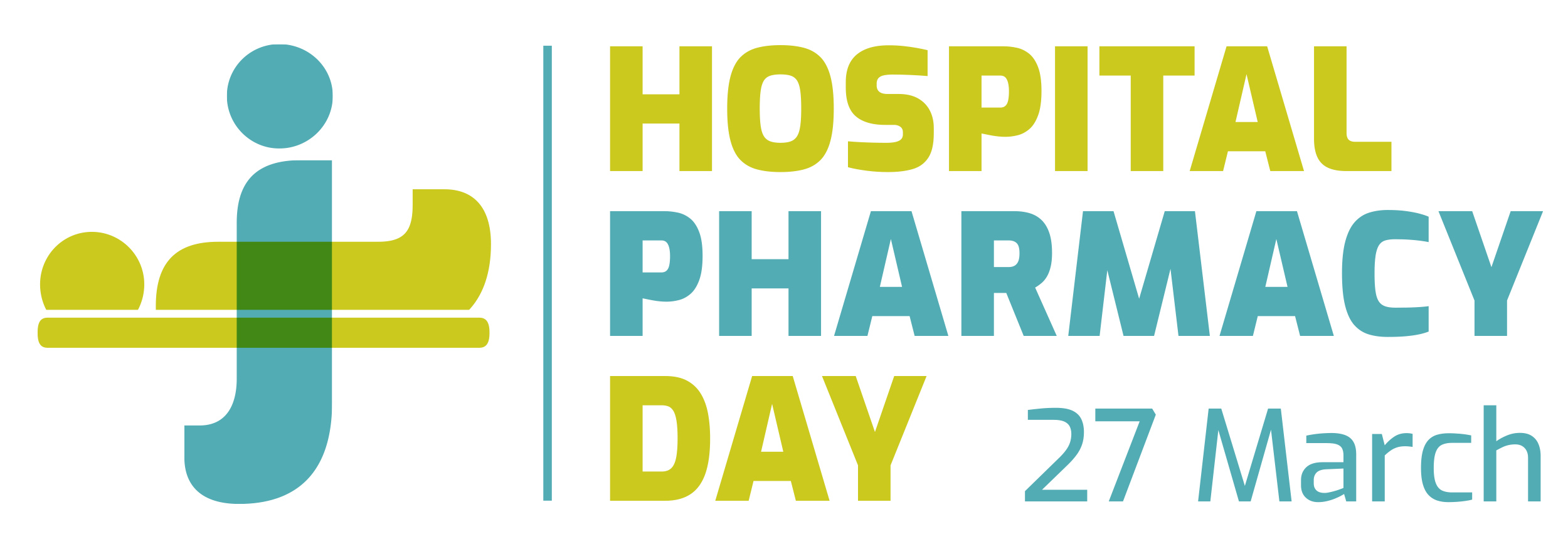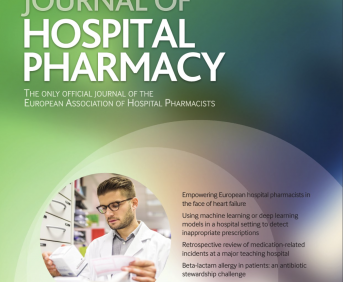Reconciliation of shared medicine record at discharge: hospital pharmacy ensures correct information on patients’ transition
Pdf

European Statement
Patient Safety and Quality Assurance
Author(s)
Linda Jeffery, Maria Grønkjær Abrahamsen, Anja Alrø Bøtkjær, Lotte Aggergaard, Ann Brit Andersen
Why was it done?
Our country has a national SMR for every citizen. The SMR shows the current medication that the citizen has been prescribed, from all sectors. All sectors can see the SMR, which is considered/ought to be the ‘truth’ about the patient’s medication. On discharge from the hospital the SMR is updated by the doctor. Afterwards, pharmacy technicians dispense medicines for discharge. The technicians, at this stage, often find discrepancies in the SMR compared to the medication prescribed and given during admission. The SMR is electronically updated but not adequately reconciled. False information in the SMR may ultimately lead to adverse drug safety events in the primary sector.
What was done?
The regional hospital pharmacy patient safety network studied how many patients do not have a reconciled electronic Shared Medication Record (SMR) at discharge, despite the doctor having electronically updated it.
How was it done?
The technician recorded the discrepancies found before contacting the doctor to get the SMR corrected.
Each discrepancy was reported into the national patient safety database.
The technicians do not dispense medicines to all discharged patients, so our results were extrapolated to all discharged patients in the time period (there was no reason to expect bias).
The study was carried out in the whole region (5 hospitals) during the same week in September 2022.
What has been achieved?
Preliminary data shows that 994 patients were discharged from the wards studied.
Technicians dispensed medicines to 278 patients. They found one or more discrepancies in 65 SMRs (23,4%).
Extrapolation of these results revealed that, in the period, there were potentially 232 patients with drug-related problems from these wards (and approx. 17,000/year in the region).
What next?
Our results showed that the SMR is not adequately reconciled in 23% of discharges, despite the doctor feeling that the task is completed. This gives drug related problems in the primary sector, often resulting in calls to the ward etc. that are time consuming and difficult to solve after discharge. Updating the SMR at discharge is essential for patient safety under transition of care. Our results will be brought to the hospital administrations, patient safety organisations and the regional medicines board for further discussion about the problem and possible solutions.
Prescription review of digoxin-treated inpatients: Pharmacist involvement in its pharmacokinetic monitoring and dosage adjustment
Pdf

European Statement
Clinical Pharmacy Services
Author(s)
DEL RIO GUTIERREZ JOSE MANUEL, MARTA MIARONS FONT, SONIA GARCIA GARCIA, TONI SORIANO COLOMÉ, ALBA PAU PARRA, ARIADNA GRACIA MOYA, NIEVES HERRANZ MUÑOZ, BRUNO MONTORO RONSANO, PAU RELLO SABATE, GERARD ORISTRELL SANTAMARIA, MARIA QUERALT GORGAS TORNER
Why was it done?
Digoxin is a drug frequently implicated in medication errors due to its difficult clinical management. It has also been observed that digoxin pharmacokinetics could change in acute medical conditions, compromising its effectiveness and safety. As hospital pharmacists, we have the opportunity to review which dose is the most appropriate for every patient.
What was done?
Twice-weekly active and extensive pharmaceutical review of digoxin-treated inpatients was established to identify whether the prescription was adequate and to adjust dosage according to plasma concentrations (PCs) and clinical situation.
How was it done?
1. A multidisciplinary team comprising pharmacists and cardiologists was created to identify possible solutions to improve digoxin prescribing.
2. It was agreed that a twice-weekly extensive review of digoxin-treated inpatients would be conducted by a pharmacist. Candidates for digoxin monitoring were:
a. Patients on chronic digoxin therapy and with at least one of the following risk factors: presence of renal failure (RF), recent surgery, elderly patients (≥65 years), critically ill patients, or patients with suspected toxicity.
3. Once the patients were identified by the pharmacist, they would be discussed with the cardiology team.
4. Digoxin prescriber would be contacted to recommend performing a determination of digoxin PC. PC reference range was set at 0.8–1.2 µg/L for atrial fibrillation (AF) and 0.5–0.8 µg/L for heart failure (HF).
5. PCs would be interpreted using a pharmacokinetic monitoring software (PKS Abbot).
6. Monitoring results and recommended dosage adjustments would be communicated.
What has been achieved?
From August 2021 to May 2022, 190 patients were identified. Sixty-five (33.7%) were considered for monitoring, of whom 21 (32.3%) were women. The average age was 77.9 (SD 11.7). Sixty-five (100%) with AF and 8 (12.3%) also with HF. The most prevalent risk factors warranting monitoring were patients aged 65 years or older (N=57, 61.9%) and RF (N=31, 33.7%). Thirty-three (51%) of monitored patients required a dosage adjustment, of whom 23 (69.8%) required a dose decrease, 5 (15.1%) an increase and 5 (15.1%) to stop the treatment. Median digoxin concentrations were 1.23 µg/L (interquartile range: 0.75-2.03).
What next?
The process described applies to any centre able to monitor digoxin CPs both in inpatient and outpatient settings.
Assessment of the safety of advanced therapy medicinal products (ATMP) process: a tutorial video creation module
Pdf

European Statement
Patient Safety and Quality Assurance
Author(s)
Chloé JADOUL, Audrey DURAND, Rémy TORDJEMAN, Isabelle MADELAINE, Romain de JORNA
Why was it done?
With the development of advanced therapy medicinal products (ATMPs), a specific pharmaceutical process is necessary to secure the handling of genetically modified organisms. Gene therapy includes Chimeric Antigen Receptor T (CAR-T) cell therapy as well as clinical trials with oncolytic viruses and nucleic acids. Limited experience on these new activities and high staff turnover based on resident pharmacist explain the need of additional training material to supplement written procedures. Multimedia support seems to be the most appropriate didactic tool.
What was done?
The objective of this work is to create pedagogical tools as short video clips. The final aim is to standardise hands-on training in order to improve ATMPs circuit safety.
How was it done?
All steps of each activity were listed and filmed in order to create a video database. Clinical trial mock preparations were performed to create the clinical trial tutorials whereas CAR-T cell activities were filmed in real conditions.
Clipchamp (Microsoft) video editing software is used to create tutorial videos. Repetitive parts were edited once and reused for other videos. They are part of the database videos.
As a validation, all staff members’ approbation was required.
What has been achieved?
Activities include, to this day, five gene therapy clinical trials and the CAR-T cell activities: reception, shipment to the pharmaceutical hub, thawing and distribution.
We filmed 55 step clips and edited six repetitive parts. Finally, eight tutorial videos were created: three for clinical trials and four for different CAR-T cell activities.
To make the training more meaningful, we made dynamic videos that last no more than 5 minutes. The average time of a tutorial was 2 minutes 17 seconds.
What next?
The tutorial videos bank is created to be dynamic and can be easily adjusted. Videos of repetitive parts will be reused for new clinical trials implementation. These video tutorials allow new resident, student or technicians to be trained faster and in a more innovative way. They also allow permanent teams to benefit from a quick refresh. In order to assess the efficiency of this new process, next operators will have to read the procedure, watch the videos and will be evaluated in practice.
Development of a pharmacy-led technical assessment pathway for personal protective equipment
Pdf

European Statement
Selection, Procurement and Distribution
Author(s)
Rachel Huey, Catherine Goudy, Michael Scott
Why was it done?
The assessment process was developed in partnership with the Business Services Organisation Procurement and Logistics Service (BSOPaLS) and regional Infection Prevention and Control (IPC) colleagues in response to the outbreak of COVID-19 and escalating demand for PPE. In March 2020, early World Health Organization (WHO) guidance formed the basis of COVID-19 PPE ensemble recommendations. Prior to the COVID-19 pandemic, BSOPaLS procured such items from reputable market leaders. However, during this time of unprecedented demand on supply chains, there were many new manufacturers and suppliers with no previous experience of appropriate supply to healthcare. There were also many counterfeit goods being placed on the healthcare market.
What was done?
During the COVID-19 pandemic, the Medicines Optimisation Innovation Centre (MOIC) utilised pharmacist skills to undertake technical assessment of all Personal Protective Equipment (PPE) items procured for use across Health and Social Care Northern Ireland (HSCNI).
How was it done?
MOIC reviewed and validated all technical documentation associated with each PPE product to ensure that items procured were genuine, fit for purpose and met the relevant standards and regulations. Benchtop assessments were carried out by IPC colleagues and BSOPaLS carried out all procurement due diligence checks on potential suppliers. Early data from 1 April 2020 to 15 May 2020 showed that only 98 (16.5%) PPE offers reviewed met the required standard for approval, while 264 (44.6%) were rejected and a further 230 (38.9%) remained open. Some reasons for rejection included documentation deficiencies and misleading labelling.
What has been achieved?
This process resulted in procurement of only safe and effective products, putting safety of HSCNI staff and patients at the forefront. In addition, BSOPaLS worked closely with local manufacturers with no previous PPE experience, to establish more resilient supply chains for the future. Products manufactured locally were also assessed via this process, to ensure suitability for use within healthcare.
What next?
This efficient assessment process has now been implemented into the PPE procurement pathway for all future HSCNI purchases, enabling the application of due diligence in a transparent, robust and evidence-based manner. Provided there is opportunity to develop an appropriate knowledge base of the relevant regulations and standards, this process is transferable across many healthcare organisations.
Software tool development for reconstitution and administration of parenteral antibiotics in hospitals: an international project
Pdf

European Statement
Patient Safety and Quality Assurance
Author(s)
Zora Ćetković, Dragana Rajinac, Ivana Baralić , Jelena Marković, Darija Kuruc Poje, Miroslav Kota, Špela Urh, Irina Tegelj, Vesna Bizjak, Dragana Mitrić, Tijana Kovačević, Andrej Pečet, Irena Radivojša, Sanja Filkova, Vesna Bašić-Milošević
Why was it done?
Medication errors regarding reconstitution and administration of parenteral antibiotics are frequent in hospitals. In our study conducted in 12 Southeastern European hospitals in 2021, we demonstrated the need of parenteral antibiotic reconstitution/dilution database in hospital pharmacy practice. Moreover, according to European Statements of Hospital Pharmacy (statement 5.5.), implementation of electronic decision support system by HPs should help to decrease the risk of medication errors. The purpose of software tools is to gather all relevant information regarding parenteral antibiotic reconstitution/dilution and make them easily accessible.
What was done?
A group of hospital pharmacists (HPs) from 6 Southeastern European countries created new software tools (a mobile-responsive website and mobile applications for Android and iOS) for providing information on reconstitution and administration of parenteral antibiotics in collaboration with software developer. These tools contain parenteral antibiotic reconstitution/dilution database in seven different languages (English, Serbian, Croatian, Slovenian, Bosnian, Macedonian and Montenegrin).
How was it done?
Technical requirements for website and mobile applications were designed by HPs. The development of these software tools was carried out by a software developer and funded by European Association of Hospital Pharmacists (EAHP). The final version of the software went through a rigorous evaluation, conducted by HPs during development and all technical problems were resolved consequently.
What has been achieved?
· Designing and developing these software tools helps HPs to provide evidence-based information about parenteral antibiotic reconstitution/dilution at the point of care, thus improving decision-making process and patient safety. · Reconstitution of parenteral antibiotics in wards is efficient and smooth. · Oral and written instructions for parenteral antibiotic reconstitution/dilution are replaced by electronic decision support tools, designed to prevent medication errors. · HP’s interventions are required to support the use of these software tools.
What next?
Our next challenge is wider use of these software tools in order to ensure the appropriate reconstitution/dilution of parenteral antibiotics in wards by nurses and physicians. These software tools are applicable in hospital setting and can be used by all regional hospitals. Additionally, they can be easily incorporated in hospital information system. We also plan to update periodically antibiotic reconstitution/dilution database, as new information becomes available.
Application of a supplier qualification program for primary packaging materials regulated as medical devices
Pdf

European Statement
Patient Safety and Quality Assurance
Author(s)
Andersen Lilli Moeller, Hansen Tove Solveig, Schnor Trine
Why was it done?
The QMS for the hospital pharmacy did not previously include primary packaging systems regulated by MDR. These packaging systems are a prerequisite for supply to patients of vital medicines like Total Parental Nutrition (TPN) and ready-to-use products such as antibiotics, cytostatics and pain reliefs.
What was done?
Several actions to combine Good Manufacturing Practice (GMP) and Medical Device Regulations (MDR1) were implemented. Among others, comprehensive training programmes were conducted, and quality standards as well as supply chain mappings were included in Quality Management Systems (QMS).
How was it done?
A national strategic initiative was launched with actions decided in open dialogue with the Competent Authority and suppliers.
Priority was given to the most GMP-critical devices as TPN-bags and elastomeric pumps. Specifications were established and supply chains mapped.
To fast roll out competences across hospital pharmacies similar workshops with participation of a consultant with special competences within MDR were given.
What has been achieved?
Due to knowledge of the Supply Chain and extended cooperation with suppliers, a quick and effective reaction in relation to for example recalls is obtained.
Easier to explain suppliers how they can support our need for documentation to fulfill GMP related demands New clinical or political demands to ad-hoc compounding can be met fast and effective.
GMP related issues are part of a current national tender for elastomeric pumps.
What next?
More medical devices like transfer-sets, syringes used as utensils and gloves to be included in the supplier qualification program.
GMP related requirements to be a part of tenders on medical devices used as packaging systems.
Continued cooperation with suppliers to develop solutions in the interface between MDR and GMP.
Integration of a hospital pharmacy preparer within a new interventional technical platform
European Statement
Selection, Procurement and Distribution
Author(s)
Morgane HOUIX, Valérie VIAUD, Cécilia HURLUPE, Yannick POIRIER
Why was it done?
The pooling of stock for the 5 rooms required a referent for stock management. In order to free up caregivers from the administrative and logistical tasks related to pharmaceutical products, pharmacy has been directly integrated into the project of ITP.
What was done?
In May 2021, interventional cardiology, rhythmology and coronary angiography have been gathered in an interventional technical platform (ITP) of 5 operating rooms. A full-time hospital pharmacy preparer (HPP) position has been set up within the ITP.
How was it done?
For the success of the project, the 2 chosen PPH had to easily becoming part of ITP’s teams and must learn specifics of medical devices of each speciality. For this purpose an immersion in each sector was carried out during the installation of the ITP and continues today by participating in interventions. They shared in the process of installing the PTI’s arsenal of pharmaceuticals with careteams by grouping the initials allocations of products of each speciality. The products common to each endowment were gathered and harmonized after discussion with caregivers. Each sector has kept a stock of specific devices, called “out-of-stock”.
What has been achieved?
The installation took about 632 hours of HPP time. The allocations for each sector were respectively 68, 69 and 83 references, not including out-of-stock. The HPP’s work allowed reducing the common endowment from 220 to 134 products references. A satisfaction survey of PTI teams (doctors, nurses,…) after 4 months of practice showed a level of 78% of satisfaction. 1.3% of the responses concerned activities related the management of devices affected by production delay or stoppage and information on product changes to be unsatisfactory or moderately satisfactory. Every ITP teams now considers their presence essential, believes that it has improved relations with the pharmacy and management of stocks. A saving in nursing time was also noted.
What next?
The creation of this HPP position seems to satisfy all the ITP teams. A quantitative analysis of the benefits measuring the impact on care time, the amount of over-storage and the compliance indicators of the implantable medical device circuit will be carried out during 1 year, in order to assess the impact of the creation of HPP positions within the PTI.
Project for the optimization of processes for the reception, conditioning and storage of medicines
European Statement
Production and Compounding
Author(s)
PATRICIA ORTIZ FERNANDEZ, Alba Maria Martinez Soto, PILAR FERNANDEZ-VILLACAÑAS FERNANDEZ, IGNACIO SALAR VALVERDE
Why was it done?
The objective is to improve patient safety, detecting mistake in real time. Review good work practices and achieve greater effectiveness. Improve the communication of the work team.
What was done?
Improve the quality of the reception, conditioning and storage processes that are carried out in the pharmacy service using tools that in the field of quality have shown great effectiveness. Simplify processes and update work instructions and standardize these. Establish quality indicators.
How was it done?
ing the `Lean healthcare´methodology based on eliminating inefficiencies in work processes and identifying opportunities for improvement which are specific, measurable, achievable, relevant and time bounded. Another of the methodologies used is the `5S´ (five basic elements: selection, systematization, cleaning, normalization and self-discipline) and `PDCA´(plan, do, check, act).
1. Establish a multidisciplinary group.
2. Training on the methodology developed in 5 sessions.
3. Elaboration of a project charter with the objetives, the scope and the planning.
4. Analyze the chosen processes with the following dynamics: a) Team visit to the work area, b) Interview an expert from each process, c) Registration of inefficiencies and process data in a value steam mapping, d) Compilation of possible improvement actions, e) Meeting for consensus and realization of an action plan to prioritize and assign those responsible for carrying out the improvement actions.
What has been achieved?
Number of meetings with the multidisciplinary team: 10
Reception process: improvements implemented(II): 11, pending improvements (PI): 2, indicators evaluated (IE): 4
Conditioning process: II: 4, PI: 0, IE: 2
Storage process: II: 13, PI: 2, IE: 2
What next?
Must be maintained and evaluated over time and anytime there that may be a change. These improvements allowed a better anticipation. The process improvement approach aimed to identify solutions was very fruitful and led to outcome practical. This method could be applied to improve other types of processes in our pharmacy service.
Improving medication barcode identification on the smallest unit of use: Start-up first ePIL (electronic leaflet) project for medicines used in hospitals in Spain
European Statement
Patient Safety and Quality Assurance
Author(s)
E Sulleiro, C Garrido, A Santamartina, O Delgado, B Aguado, I Alvarez Novoa, M Amérigo , L Calatayud, M Cardenal, J Carretero , J Corredoira, MA De la Peña, MJ De la Torre, S Domingo-Carranza, M Ercep, E Emili, M Eugui, E Falco, M Garcia , S Hernandez, M Hidalgo, J Hierro, M Jamali, C Joglar, S Juan, N Longás, A Lopez de la Rica, JJ Martínez , M MIllán , P Paris, C Ramirez, M Serrano
Why was it done?
Medication errors are one of the most common causes of preventable adverse events in the healthcare system. A complete identification of a medicine, up to the moment of administration, is therefore a key element of a safe medicines dispensing procedure in hospitals.
Digitization is a trend affecting all levels of our society and medicines are no exception. Increased use of Datamatrix code in the outer packaging of medicines has facilitated many healthcare professionals to become familiar with this technology. It is now possible to easily retrieve online information about a medicine, which raises the possibility of obtaining updated information of medicines without necessarily using a paper leaflet. Moreover, paper leaflets in the hospital setting are very often disposed of without reaching their end user, the patient.
Additionally, hospitals have other needs closely related to digitalization, considering errors in the reconciliation of prescription versus dispensing and administration, that can be reduced due to automated capture of the code linked to a particular medicine in the smallest unit of use, and also when dealing with compounding traceability preparations for patients.
What was done?
Spanish Agency of Medicines and Medical Devices (AEMPS), Spanish Society of Hospital Pharmacy in coordination with Hospital Committee of the General Council of Official Pharmacist Associations , and a series of pharmaceutical companies, mostly integrated in National Trade Association of the Spanish based pharmaceutical industry (Farmaindustria), have launched a project consisting of removing paper leaflet from the packaging components of a series of medicines exclusively administered in hospitals. These medicines will have a Datamatrix code in the primary packaging. When scanned, Datamatrix will allow to capture official PIL text from the information hosted in the Medicine Online Information Center of AEMPS (CIMA), which can be used for patient safety purposes at hospital pharmacy.
How was it done?
The Project began in November 2020 creating an ad-hoc working group on “Technical Regulation of Pharmaceutical Medicines” from Farmaindustria with AEMPS and representatives of Hospital Pharmacists. After 10 TCs and after having the participation of different partners, the main lines were agreed
Stakeholders agreed a proposal for pilot description and AEMPS informed the European Commissionin due course.
What has been achieved?
1. From January, 1 2022, a list of medicines meeting the established requirements will be able to be marketed without paper leaflet
2. Non-serialized Datamatrix will be included in the primary packaging, shall be compliant with GS1 standardization and may be pre-printed. It will contain specific NTIN/GTIN that will enable access through a correspondence table to Marketing Authorization Number (pharmaceutical form and dose) of the medicine hosted in AEMPS Nomenclator for Prescription (a medicine database intended to provide core prescription information to the care information services). In case technically feasible, companies may include also batch variable information such as Batch Number and Expiry date in the Datamatrix on a voluntary basis.
What next?
Assessing the impact of this practice in terms of efficiency, flexibility and safety is a key priority and this pilot project will gather enough data and information to help EC and Member States to revise relevant provisions in the legislation by 2022.
EU citizens will be able to benefit from the development of new technologies, as an underlying driver for delivering timely and easily accessible an up-to-date medicinal product information,
ASfarMA Project. HUMANIZATION OF PHARMACEUTICAL CARE FOR PATIENTS WITH SEVERE ASTHMA
European Statement
Introductory Statements and Governance
Author(s)
Hilario Martinez-Barros, Maria Muñoz-Garcia, David Gonzalez-de-Olano, Silvia Sanchez-Cuellar, Enrique Blitz-Castro, Gonzalo De-los-Santos-Granados, Dario Antolin-Amerigo, Ana de-Andres-Martin, Patricia Fernandez-Martin, Elena Gemeno-lopez, Ana Maria Alvarez-Diaz
Why was it done?
• To understand directly and holistically the patients’ vision of their illness, treatment, healthcare experience and how they impact their daily lives.
• To define the ideal SAU by identifying innovations and changes that satisfy patients’ needs.
What was done?
ASfarMA is a hospital pharmacist-led project within a multidisciplinary Severe Asthma Unit (SAU) that aims to apply different innovative measures encompassing humanization to improve treatment related results and patient experiences.
How was it done?
Human-Centered Design (HCD) is an approach to problem-solving that aims to make systems usable and useful by focusing on the users and their needs.
A core group was constituted with at least one member from each of the specialities that are part of our SAU. Members of an HCD-team devised and contributed to organize the following activities:
- A first core group session was held in which, using different dynamics, 4 patient archetypes were identified, and the patients´ journey through the Unit was described.
- HCD-team members interviewed both SAU professionals and 8 patients who matched the previously defined archetypes. The latter was also given a patient diary designed to obtain descriptive and emotional information within the SAU.
- Utilizing the previously obtained data, a co-creation workshop was held by the HCD-team involving both the core group and the participating patients.
What has been achieved?
A series of proposed measures that respond to patients and professionals’ reported needs were made. They were classified as either “transformative solutions” or “quick wins”:
– 7 transformative solutions, which provide holistic responses that require greater development, effort and resources, were identified. E.g. Two-way communication APP, onboarding kit, design of common spaces for SAU members, patient coordinator.
– 14 quick wins, which provide significant benefits but can be implemented with lesser effort and resources, were identified. E.g. Non-urgent consultation mailbox, pediatric-adult patient transition consultation, asthma-specific emergency department circuits, coordinated consultation agendas between severe asthma unit members, expert patient workshops.
What next?
This project, which has a qualitative nature and is based on the experiences of both patients and professionals, has allowed us to understand their needs and identify innovative solutions that will be applied progressively to our SAU and other hospitals.





